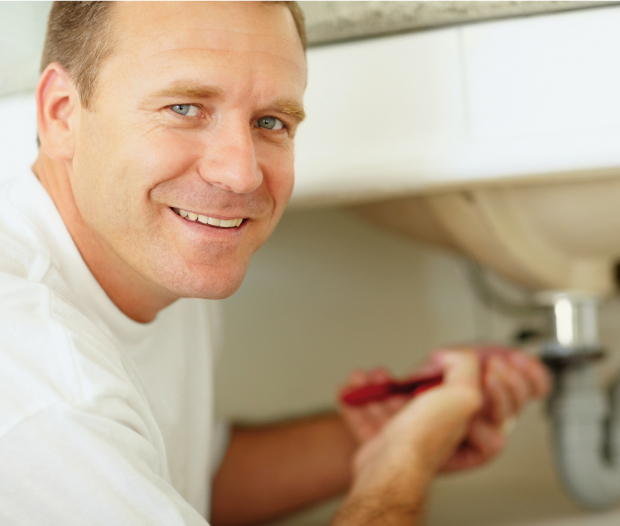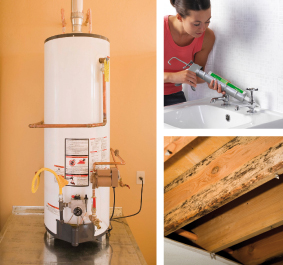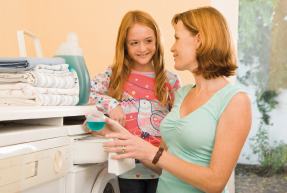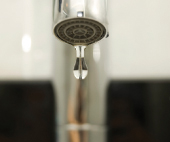Water Damage at Home: Preventing a Flood of Problems
 With the devastation of tornadoes, hurricanes and floods sweeping through the United States the past few years, we are all reminded of the need to be prepared for disasters. October is Disaster Preparedness Month, so there is no better time to get ready.
With the devastation of tornadoes, hurricanes and floods sweeping through the United States the past few years, we are all reminded of the need to be prepared for disasters. October is Disaster Preparedness Month, so there is no better time to get ready.
Disasters aren’t limited to hurricanes and tornadoes, however. They can occur in our own homes, from something as simple as a leaking water pipe. Fortunately for us, the old adage “an ounce of prevention is worth a pound of cure” still rings true. Prevention can help us dodge the financial, physical and emotional stress involved with water damage.
Most water disasters are controllable and easily preventable. They most commonly occur in the following places:
• Old supply hoses for washing machines and dishwashers that burst due to old age
•Water supply tubing to ice makers that split causing small leaks that may go unnoticed for some time, allowing the water to soak into the walls below
• Frozen pipes that leak when they thaw
• Water heaters that begin to leak due to old age and corrosion
• Improper or deteriorated caulking around tubs and showers that allows water to seep into the floor below
• Air conditioner drain lines that become plugged and develop a slow leak that soaks into the floor or wall
 Checking these areas periodically for signs of wear and tear can prevent a big mess, saving you the time, money and stress of a major water problem.
Checking these areas periodically for signs of wear and tear can prevent a big mess, saving you the time, money and stress of a major water problem.
One factor that makes water damage so difficult is that it tends to be sneaky, causing damage before you notice it—particularly in appliance water supply lines, like dishwashers and ice makers. “Many times people don’t notice it right away, especially if they have hardwood flooring in the kitchen, because it seeps between boards and doesn’t appear wet,” says Dan Taylor of Kidd’s Cleaning and Restoration Services. The ice maker connector can eventually go bad and leak, and the dishwasher water supply line can also wear out. A great way to prevent this is to purchase leakproof connectors. Taylor says that these preventive measures are well worth the time and money.
According to Quinn Mongan of Servpro, their fire and water clean-up and restoration company receives a lot of calls regarding water heaters. “Homeowners need to do a visual inspection of their water heaters annually to check for any signs of corrosion and drips,” Mongan says. Some experts suggest that you shouldn’t wait for your water tank to fail; water heaters last on average 10 to 12 years, so consider replacing them once a decade. Today’s energy-efficient systems will also be cheaper to operate.
 In Case of Emergency
In Case of Emergency
Experts at Consolidated Construction Services, a local restoration company, say that in a water disaster, time is of the essence, and that homeowners should know where their main shut-off is located. The first thing they should do is turn off the main water supply to the house—something some people may not even know where to find. Servpro’s Mongan urges all homeowners to be aware of this location before it’s too late. If it is not easily accessible, then pay a plumber to relocate or install it where it is accessible.
Water damage not only causes financial and physical stress, but it can also pose a significant health and safety risk. “Flooding is a biohazard because substances such as oil, gasoline and raw sewage may be in the water,” Mongan says. Also, flooding can result in animals, like snakes, moving into your home.
Mold growth in water-damaged areas can also be a problem. And new building methods have created an environment in homes that can be even more inviting to mold, according to Taylor. “New home construction over the years has become so good at building a ‘tight’ house related to air containment that it can create a growth environment for mold—especially if indoor air is not exchanging frequently with outdoor air,” Taylor says. As a result, the state of Virginia began a program which regulates mold inspections starting July 1.
 Homeowners often mistakenly assume that the possibility of mold is eliminated if the floor is dry to the touch. However, mold is much more complicated than that. Cleaning and restoration companies can use state-of-the-art equipment to tackle this problem, including psychometric charts to plot moisture levels, thermal imaging to locate wet areas, and moisture meters to help guide them in their plan of action.
Homeowners often mistakenly assume that the possibility of mold is eliminated if the floor is dry to the touch. However, mold is much more complicated than that. Cleaning and restoration companies can use state-of-the-art equipment to tackle this problem, including psychometric charts to plot moisture levels, thermal imaging to locate wet areas, and moisture meters to help guide them in their plan of action.
Electric shock is also a major concern. In the event of a water disaster, it’s important to turn off your electricity. Consolidated Construction Services says that this is another reason for homeowners to let the professionals deal with damaged rooms containing standing water.
Before allowing a company to work on your home, you should make sure that they are qualified and certified to deal with water losses and mold issues. Check references, ask friends, and confirm that the company you’ve chosen to help has the needed industry certifications.
While the chances of being hit by a tornado or hurricane may be low, the chances of having water damage in your home are very real—particularly if you don’t take steps to prevent it. Remember to inspect your hoses and drain pipes, replace items that are damaged and identify your main water shut-off valve and your main electricity disconnect for ready use should an unexpected event occur. Finally, review your insurance information to know whom to call if disaster strikes. A professional water damage restoration company will work with your insurance agency to make sure that your water damage is properly corrected.






